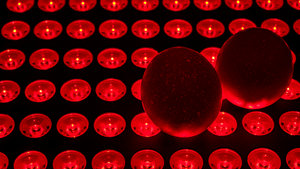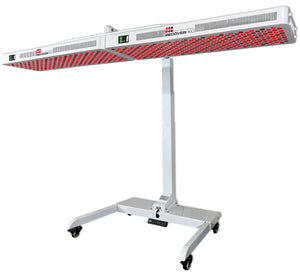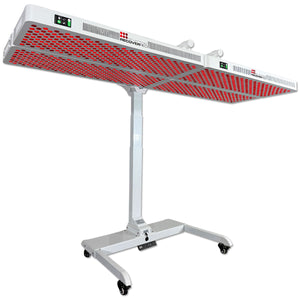Red light therapy (RLT) involves the therapeutic application of low-wavelength red light, typically ranging from 620 to 750 nanometers. Due to its safety and minimal side effects, it has gained popularity as an alternative to traditional treatments like creams, lasers, and dermabrasion.
This treatment has been reported to improve the appearance of the skin by reducing scars, acne, redness, and wrinkles. [1] It is also being investigated for its potential benefits in treating other medical conditions.
The History of Red Light Therapy
The concept of cells absorbing sunlight and using it as an energy source is not new. Ancient cultures used sunlight for treating various conditions. NASA's initial experiments with red light therapy focused on plant growth in space and wound healing in astronauts. [2]
This led to further investigations and the discovery of its effectiveness in photodynamic therapy for treating skin conditions, including skin cancer and psoriasis. Today, red light therapy is studied and used for various health conditions.
How Does Red Light Therapy Work?
Red light therapy (RLT) works by using low-intensity red and near-infrared radiation to stimulate energy production in the mitochondria of cells, a process known as photobiomodulation. Mitochondria are like small power generators found in cells that convert air, water, and food into energy, which is essential for cell growth and function.
It promotes the production of essential proteins like collagen and elastin by supporting the extracellular matrix (ECM) through increased fuel and oxygen utilization. [3] This results in improved skin elasticity, strength, and contraction ability.
Common Skin Conditions and Red Light Therapy
Red light therapy is gaining attention as a potential treatment for various skin conditions. It is being tried to address the following concerns:
- Restoring sun-damaged skin
- Improving wound healing
- Diminishing wrinkles, fine lines, acne, and age spots [4]
- Reducing stretch marks
- Minimizing scars
- Enhancing facial texture
- Managing psoriasis, rosacea, and eczema
- Promoting hair growth in individuals with androgenic alopecia
Potential Benefits of Red Light Therapy for Skin
Red light therapy offers various potential benefits for the skin, including:
- Enhancing collagen production: Red light therapy stimulates collagen production, resulting in youthful skin and reduced visibility of lines and wrinkles. [5]
- Boosting circulation: By increasing blood flow to the skin, more oxygen and nutrients are delivered to the cells.
- Tightening the skin: RLT contributes to firmer skin by stimulating collagen and elastin production.
- Stimulating fibroblast activity: These specialized cells produce collagen and elastin, essential proteins for skin structure and elasticity.
- Reducing pore size: As collagen production increases, the appearance of pores may decrease.
- Easing inflammation: The increased energy from red light therapy helps reduce cellular inflammation, preventing skin cell damage and alleviating redness and premature aging. [6]
- Fading scars and acne: Red light therapy aids in healing acne-induced wounds by promoting collagen production. Its anti-inflammatory effects can also help calm breakouts.
- Soothing sun damage: RLT assists in repairing skin damage caused by exposure to UV rays from the sun.
Is Red Light Therapy Safe?
For most people, red light therapy is safe and has minimal side effects. However, some individuals may experience temporary eye irritation, a burning sensation, or skin irritation, particularly those with sensitive skin.
It's recommended to wear eye protection during treatment if the light feels uncomfortable. Red light therapy uses a different wavelength from UV light, so concerns about skin cancer or premature skin aging are not applicable.
The Bottom Line
Red light therapy offers a non-invasive and safe approach to improve skin health and address certain medical conditions. By stimulating energy production in cells, it enhances the regeneration and healing of skin cells while promoting the production of vital proteins.
While the potential benefits of red light therapy are promising, it's important to consult with a healthcare professional and consider the available scientific evidence before making a decision.
Reference
- DJ, G. (2006). Combined 633-nm and 830-nm led treatment of photoaging skin. Journal of drugs in dermatology : JDD. https://pubmed.ncbi.nlm.nih.gov/16989189/
- Author , A. (2022). NASA research illuminates medical uses of light. NASA. https://spinoff.nasa.gov/NASA-Research-Illuminates-Medical-Uses-of-Light
- Freitas, L. (2016). Proposed mechanisms of photobiomodulation or low level light therapy. Proposed Mechanisms of Photobiomodulation or Low Level Light Therapy. https://www.researchgate.net/publication/303890737_Proposed_Mechanisms_of_Photobiomodulation_or_Low_Level_Light_Therapy
- M, A. (2016). Laser and light-based treatments of acne and acne scarring. Clinics in dermatology. https://pubmed.ncbi.nlm.nih.gov/28274357/
- Rocha Mota, L., Motta, L. J., Duarte, I. da S., Horliana, A. C. R. T., Silva, D. de F. T. da, & Pavani, C. (2018, May 31). Efficacy of phototherapy to treat facial ageing when using a red versus an amber led: A protocol for a randomised controlled trial. BMJ open. https://www.ncbi.nlm.nih.gov/pmc/articles/PMC5988166/
- MR, H. (2017). Mechanisms and applications of the anti-inflammatory effects of photobiomodulation. AIMS biophysics. https://pubmed.ncbi.nlm.nih.gov/28748217/




